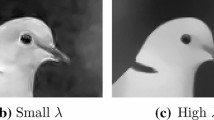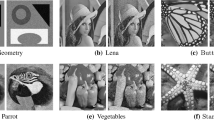Abstract
In this article, we introduce an advanced approach for enhanced image denoising using an improved space-variant anisotropic Partial Differential Equation (PDE) framework. Leveraging Weickert-type operators, this method relies on two critical parameters: \(\lambda \) and \(\theta \), defining local image geometry and smoothing strength. We propose an automatic parameter estimation technique rooted in PDE-constrained optimization, incorporating supplementary information from the original clean image. By combining these components, our approach achieves superior image denoising, pushing the boundaries of image enhancement methods. We employed a modified Alternating Direction Method of Multipliers (ADMM) procedure for numerical optimization, demonstrating its efficacy through thorough assessments and affirming its superior performance compared to alternative denoising methods.














Similar content being viewed by others
Data availability
Data will be available on reasonable request.
References
Afraites, L., Hadri, A., Laghrib, A., Nachaoui, M.: A weighted parameter identification PDE-constrained optimization for inverse image denoising problem. Vis. Comput. 38(8), 2883–2898 (2022)
Boutaayamou, I., Hadri, A., Laghrib, A.: An optimal bilevel optimization model for the generalized total variation and anisotropic tensor parameters selection. Appl. Math. Comput. 438, 127510 (2023)
Boyd, S., Parikh, N., Chu, E., Peleato, B., Eckstein, J.: Distributed optimization and statistical learning via the alternating direction method of multipliers. Found. Trends Mach. Learn. 3(1), 1–122 (2011)
Brezis, H.: Analyse Fonctionnelle. Masson, Paris (1983)
Chambolle, A., Pock, T.: A first-order primal-dual algorithm for convex problems with applications to imaging. J. Math. Imaging Vis. 40, 120–145 (2011). (Publisher: Springer)
Chatterjee, P., Milanfar, P.: Patch-based near-optimal image denoising. IEEE Trans. Image Process. 21(4), 1635–1649 (2012)
Chen, G., Xie, W., Zhao, Y.: Wavelet-based denoising: a brief review. In: 2013 fourth international conference on intelligent control and information processing (ICICIP), pp. 570–574. IEEE, (2013)
Chen, Y., Li, J., Zhou, Y.: Hyperspectral image denoising by total variation-regularized bilinear factorization. Signal Process. 174, 107645 (2020)
Chen, Y., Xu, T., Zhao, X., Zeng, H., Xu, Y., Chen, J.: Asymmetry total variation and framelet regularized nonconvex low-rank tensor completion. Signal Process. 206, 108901 (2023)
Clason, C., Valkonen, T.: Primal-dual extragradient methods for nonlinear nonsmooth PDE-constrained optimization. SIAM J. Optim. 27(3), 1314–1339 (2017). (Publisher: SIAM)
Cui, Y., Yin, L., Zhou, H., Gao, M., Tang, X., Deng, Y., Liang, Y.: Compressed sensing based on L1 and TGV regularization for low-light-level images denoising. Digital Signal Process. 136, 103975 (2023)
Dawant, B.M., Zijdenbos, A.P.: Image segmentation. In: De, T. (ed.) Handbook of Medical Imaging, vol. 2, pp. 71–127. SPIE Press, Bellingham (2000)
El Mourabit, I., El Rhabi, M., Hakim, A., Laghrib, A., Moreau, E.: A new denoising model for multi-frame super-resolution image reconstruction. Signal Process. 132, 51–65 (2017)
Gao, J., Sun, J., Yao, W., Guo, Z.: A novel fractional-order reaction diffusion system for the multiplicative noise removal. Stud. Appl. Math. 147(2), 421–447 (2021)
Ghose, S., Singh, N., Singh, P.: Image denoising using deep learning: convolutional neural network. In: 2020 10th International Conference on Cloud Computing, Data Science & Engineering (Confluence), pp. 511–517, (2020)
Glowinski, R., Song, Y., Yuan, X.: An ADMM numerical approach to linear parabolic state constrained optimal control problems. Numerische Mathematik 144, 931–966 (2020)
Gonzalez, R.C., Woods, R.E.: Digital Image Processing, pp. 653–658. Pearson education India (2006)
Hadri, A., Afraites, L., Laghrib, A., Nachaoui, M.: A novel image denoising approach based on a non-convex constrained PDE: application to ultrasound images. SIViP 15(5), 1057–1064 (2021)
Hadri, A., Laghrib, A., El Mourabit, I.: A new learning space-variant anisotropic constrained-PDE for image denoising. Appl. Math. Model. 125, 139–163 (2023)
He, N., Wang, J.-B., Zhang, L.-L., Lu, K.: An improved fractional-order differentiation model for image denoising. Signal Process. 112, 180–188 (2015)
Jia, X., Liu, S., Feng, X., Zhang, L.: Focnet: a fractional optimal control network for image denoising. In: Proceedings of the IEEE/CVF conference on computer vision and pattern recognition, pp. 6054–6063, (2019)
Jin, B., Zhou, Z.: An inverse potential problem for subdiffusion: stability and reconstruction. Inverse Prob. 37(1), 015006 (2020)
Kabanikhin, S.I., Kowar, R., Scherzer, O.: On the Landweber Iteration for the Solution of a Parameter Identification Problem in a Hyperbolic Partial Differential Equation of Second Order. Walter de Gruyter, Berlin (1998)
Kawar, B., Elad, M, Ermon, S., Song, J.: Denoising diffusion restoration models, Oct. 2022. arXiv:2201.11793 [cs, eess]
Kollem, S., Reddy, K.R.L., Rao, D.S.: A review of image denoising and segmentation methods based on medical images. Int. J. Mach. Learn. Comput. 9(3), 288–295 (2019)
Krull, A., Buchholz, T.-O., Jug, F.: Noise2void-learning denoising from single noisy images. In: Proceedings of the IEEE/CVF conference on computer vision and pattern recognition, pp. 2129–2137, (2019)
Lequyer, J., Philip, R., Sharma, A., Pelletier, L.: Noise2fast: fast self-supervised single image blind denoising. arXiv preprint arXiv:2108.10209, (2021)
Lu, D., Weng, Q.: A survey of image classification methods and techniques for improving classification performance. Int. J. Remote Sens. 28(5), 823–870 (2007)
Martin, D., Fowlkes, C., Tal, D., Malik, J.: A database of human segmented natural images and its application to evaluating segmentation algorithms and measuring ecological statistics. In: Proceedings Eighth IEEE International Conference on Computer Vision. ICCV 2001, vol. 2, pp. 416–423, Vancouver, BC, Canada, (2001)
Motwani, M.C., Gadiya, M.C., Motwani, R.C., Harris, F.C.: Survey of image denoising techniques. Proc. GSPX 27, 27–30 (2004)
Parikh, N., Boyd, S.: Proximal algorithms. Found. Trends Optim. 1(3), 127–239 (2014)
Perona, P., Malik, J.: Scale-space and edge detection using anisotropic diffusion. IEEE Trans. Pattern Anal. Mach. Intell. 12(7), 629–639 (1990). (Publisher: IEEE)
Pitas, I., Venetsanopoulos, A.N.: Nonlinear Digital Filters. Springer, Boston (1990)
Plessix, R.-E.: A review of the adjoint-state method for computing the gradient of a functional with geophysical applications. Geophys. J. Int. 167(2), 495–503 (2006)
Shao, J., Guo, Z., Shan, X., Zhang, C., Wu, B.: A new non-divergence diffusion equation with variable exponent for multiplicative noise removal. Nonlinear Anal. Real World Appl. 56, 103166 (2020)
Song, J. L., Chen, M. J., Jiang, C., Huang, Y. X., Liu, Q., Meng, Y., Mo, W. Q., Dong, K. F., Jin F.: Research on image denoising method based on wavelet transform. In: 2018 37th Chinese Control Conference (CCC), pp. 7354–7358. IEEE, (2018)
Song, Y., Yuan, X., Yue, H.: Implementation of the ADMM to parabolic optimal control problems with control constraints and beyond. arXiv preprint arXiv:2005.01582, (2020)
Tomasi, C., Manduchi, R.: Bilateral filtering for gray and color images. In: Sixth International Conference on Computer Vision (IEEE Cat. No.98CH36271), pp. 839–846, Narosa Publishing House, Bombay, India, (1998)
Wang, M., Zheng, S., Li, X., Qin, X.: A new image denoising method based on Gaussian filter. In: 2014 International Conference on information science, electronics and electrical engineering, vol. 1, pp.163–167. IEEE, (2014)
Wang, Z., Bovik, A., Sheikh, H., Simoncelli, E.: Image quality assessment: from error visibility to structural similarity. IEEE Trans. Image Process. 13(4), 600–612 (2004)
Wang, Z., Liu, J., Xue, J.-H.: Joint sparse model-based discriminative K-SVD for hyperspectral image classification. Signal Process. 133, 144–155 (2017)
Weickert, J.: Anisotropic Diffusion in Image Processing, vol. 1. Teubner, Stuttgart (1998)
Wen, Y., Guo, Z., Yao, W., Yan, D., Sun, J.: Hybrid BM3D and PDE filtering for non-parametric single image denoising. Signal Process. 184, 108049 (2021)
Wu, Y., Tracey, B., Natarajan, P., Noonan, J.P.: James-Stein type center pixel weights for non-local means image denoising. IEEE Signal Process. Lett. 20(4), 411–414 (2013)
Yang, G., Burger, P., Firmin, D., Underwood, S.: Structure adaptive anisotropic image filtering. Image Vis. Comput. 14(2), 135–145 (1996)
Zeghal, A.: Existence results for inverse problems associated with a nonlinear parabolic equation. J. Math. Anal. Appl. 272(1), 240–248 (2002). (Publisher: Elsevier)
Zhang, Y., Lin, H., Li, Y., Ma, H.: A patch based denoising method using deep convolutional neural network for seismic image. IEEE Access 7, 156883–156894 (2019)
Acknowledgements
The authors thank gratefully the reviewers for the pertinent remarks that improved this work.
Funding
This research was entirely funded by the institutions of the authors.
Author information
Authors and Affiliations
Corresponding author
Ethics declarations
Conflict of interest
The authors declare that they have no Conflict of interest.
Human or animal rights
Neither human participants nor animals are involved in this research.
Additional information
Publisher's Note
Springer Nature remains neutral with regard to jurisdictional claims in published maps and institutional affiliations.
Appendix
Appendix
We will show the adjoint equation of state, we consider the following Lagrangian functional defined by:
With p is the adjoint variable. By using the Green formula, we obtain
-
We compute the variation of \(\mathcal {L}\) with respect to u, we get
$$\begin{aligned} \langle \frac{\partial \mathcal {L} }{\partial u}, u' \rangle =&\langle \partial _{u}\mathcal {J}(\theta , \lambda , T),u' \rangle _{\Omega }+\int _0^1\int _{\Omega }\frac{\partial u'}{\partial t}p dx dt\\&-T\int _0^1\int _{\Omega }div\left( \textbf{D}^{\lambda }_\theta \nabla u' \right) \nabla ^{2}p dxdt\\&+T\int _0^1\int _{\Omega }\mathbf {\curlyvee }'u'\nabla u \nabla p dx dt\\&+T\int _0^1\int _{\Omega }\mathbf {\curlyvee } \nabla u' \nabla p dx dt. \end{aligned}$$Therefore,
$$\begin{aligned}&\langle \frac{\partial \mathcal {L} }{\partial u}, u' \rangle =0 \Rightarrow \langle u(.,1)-Y_{0},u'\rangle _{\Omega }\\&-\langle \frac{\partial p}{\partial t},u' \rangle _{(0,1)\times \Omega }-T\langle div^{2}\left( \textbf{D}^{\lambda }_\theta \nabla ^2 p \right) ,u' \rangle _{(0,1)\times \Omega }\\&-T\langle div\left( \mathbf {\curlyvee } \nabla p \right) ,u'\rangle _{(0,1)\times \Omega }\\&+T\langle \mathbf {\curlyvee }'\nabla u \nabla p,u' \rangle _{(0,1)\times \Omega }=0. \end{aligned}$$Then, we deduce the system (30).
-
We compute the variation of \(\mathcal {L}\) with respect to \(\theta \), we get
$$\begin{aligned}&\langle \frac{\partial \mathcal {L} }{\partial \theta }, \tilde{\theta }\rangle =\langle \partial _{\theta }\mathcal {J}(\theta , \lambda , T),\tilde{\theta } \rangle _{\Omega }\\&-T\int _0^1\int _{\Omega }\frac{\partial \textbf{D}^{\lambda }_\theta }{\partial \theta }\tilde{\theta } \nabla ^{2}u \nabla ^{2}p dx dt,\\&\langle \frac{\partial \mathcal {L} }{\partial \theta }, \tilde{\theta }\rangle =0 \Rightarrow \langle \partial _{\theta }\mathcal {J}(\theta , \lambda , T),\tilde{\theta } \rangle _{\Omega }\\&=T\langle \frac{\partial \textbf{D}^{\lambda }_\theta }{\partial \theta } \nabla ^{2}u \nabla ^{2}p,\tilde{\theta } \rangle _{(0,1)\times \Omega }. \end{aligned}$$Then,
$$\begin{aligned} \partial _{\theta }\mathcal {J}=T\frac{\partial \textbf{D}^{\lambda }_\theta }{\partial \theta } \nabla ^{2}u \nabla ^{2}p. \end{aligned}$$ -
In the same manner we compute the variation of \(\mathcal {L}\) with respect to \(\lambda \), we obtain
$$\begin{aligned} D_{\lambda } \mathcal {J} (\theta , \lambda ,T)=T\displaystyle \frac{\partial \textbf{D}_{\theta }^{\lambda }}{\partial \lambda }\nabla ^{2} u \nabla ^{2} p. \end{aligned}$$
Rights and permissions
Springer Nature or its licensor (e.g. a society or other partner) holds exclusive rights to this article under a publishing agreement with the author(s) or other rightsholder(s); author self-archiving of the accepted manuscript version of this article is solely governed by the terms of such publishing agreement and applicable law.
About this article
Cite this article
Limami, Fe., Hadri, A., Afraites, L. et al. Tensor-guided learning for image denoising using anisotropic PDEs. Machine Vision and Applications 35, 48 (2024). https://doi.org/10.1007/s00138-024-01532-4
Received:
Revised:
Accepted:
Published:
DOI: https://doi.org/10.1007/s00138-024-01532-4




